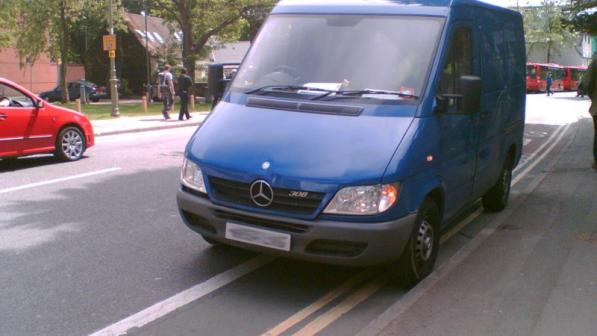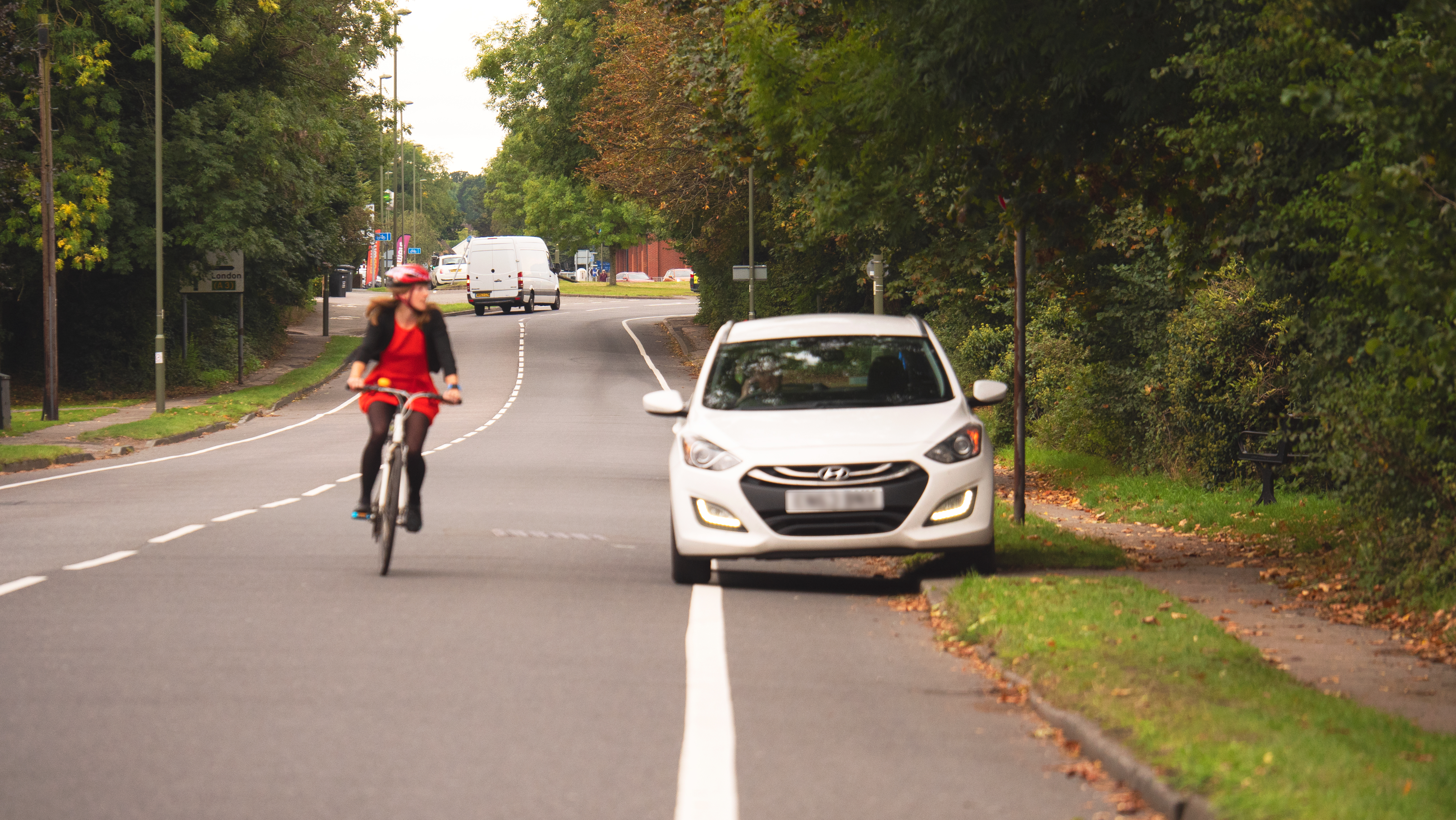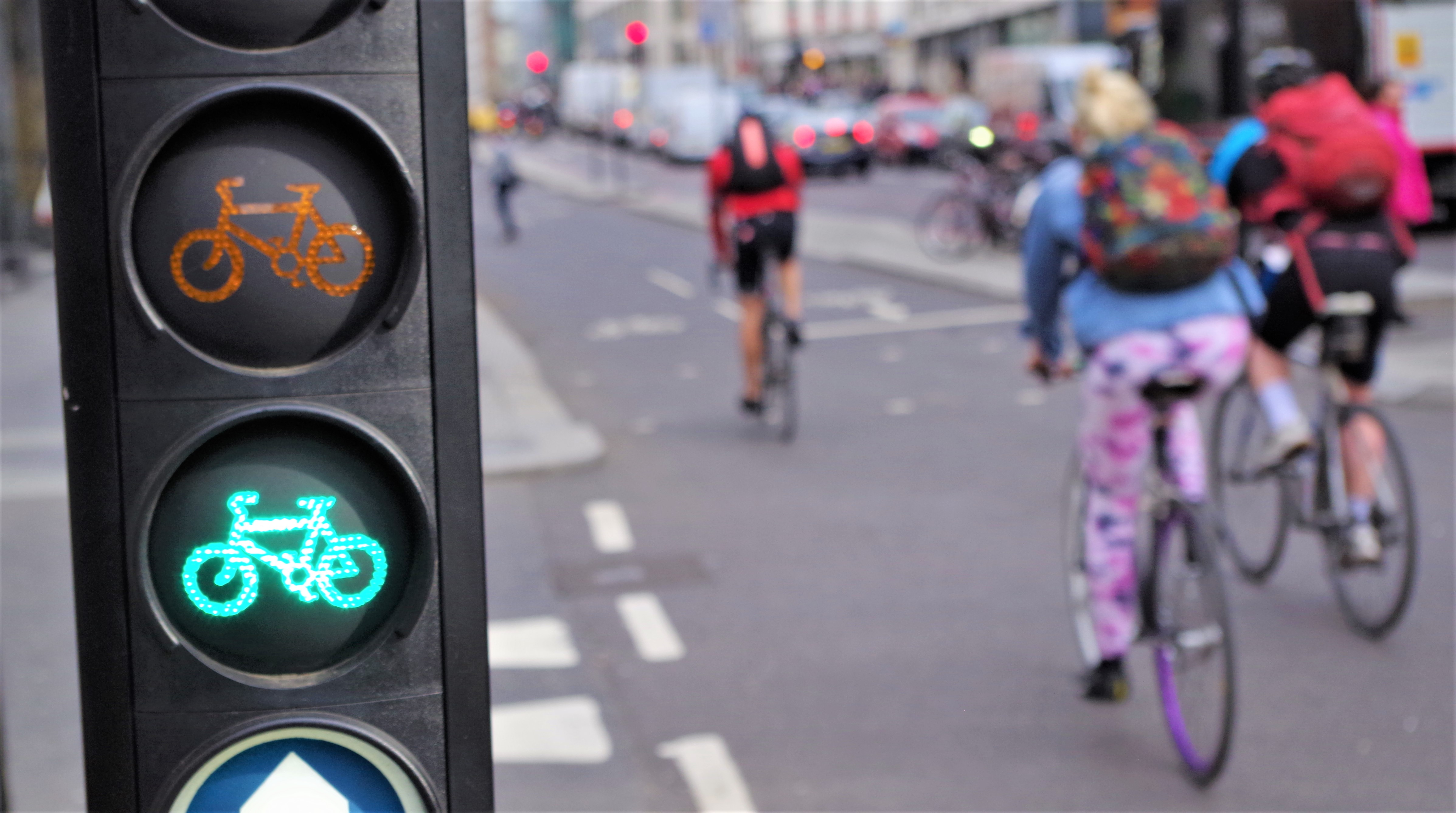Underhand law-change undermines mandatory cycle lanes

Back in November 2018, the Department for Transport (DfT) published the results of its review of cycling and walking safety. Its proposals included 50 actions to improve cycle and pedestrian safety, of which the most important was a commitment to review the Highway Code. Cycling UK strongly welcomed this, as it was one of the many things we had called for in our full response to the review (see also our ‘Cycle Safety: make it simple’ booklet, which summarises our response).
However the 50 actions also included a commitment to “Clarify to local councils the powers they have to prohibit parking in cycle lanes through civil parking enforcement powers". This puzzled me, as I thought that local authorities had no powers to enforce parking restrictions in cycle lanes. So I wrote to DfT.
Undermining cycle safety
What I uncovered was a very complex can of worms. However, the short of it is that, in 2016, DfT had quietly changed the law so that it is no longer an offence to park other types of vehicle in a mandatory cycle lane (MCL, i.e. one that is marked with a solid white line). This change was made without telling (let alone consulting) local authorities or anyone else, either before or after the change was made.
However, they’ve made this rule-change in a way that means it’s still an offence if the MCL was painted before the rule-change came into effect in 2016 – yet nobody looking at a MCL could tell which type it is.
And to make things really messy, we now have a situation where the Highway Code is out of step with the law. So, unless the Government reverses the 2016 rule change, they will soon need to make a change to the Highway Code which will worsen cycle safety, as part of a review that is supposed to improve cycle safety.
Legal background
It will probably help if I start by explaining the law, as it was before 2004. At that point, there was a clear distinction between:
- Mandatory cycle lanes (MCLs): marked with solid white lines, it is (and always has been) an offence to drive or ride a vehicle other than a pedal cycle in a MCL during its hours of operation (n.b. MCLs, like bus lanes, can operate part-time only, although part-time cycle lanes are rarer than part-time bus lanes). It also used to be an offence to park in them, however that has now changed.
- Advisory cycle lanes (ACLs): marked with dashed white lines, these are (as their name suggests) purely advisory, i.e. they have no formal legal meaning. However, the advisory rule urging drivers to keep out of them would (slightly) increase the liabilities of someone driving who hit a cyclist in an advisory cycle lane compared with the same situation if the ACL wasn’t there.
This distinction, and the different road markings associated with these two types of cycle lane, was set out in the definitions of cycle lanes as given in section 4 of the Traffic Signs Regulations and General Directions 2002. TSRGD is the mammoth set of regulations which defines the road signs and markings that highway authorities can legally use either to give advice to road users or to convey regulatory requirements (e.g. speed limits, limits on vehicles’ height, weight or width, no entries, one-way streets and banned turning movements). Every sign or marking has a 'diagram' in TSRGD, with supporting information on its correct size and positioning, the lighting requirements for road signs, and the permutations and combinations of signs and markings that can, or must, be used with one another. You can imagine, it makes for wonderful bed-time reading!
At the time of TSRGD 2002, the solid white line we are interested in was known as the 'marking to diagram 1049' (you can find it in Schedule 6 of the regulations). Its meaning depended on which regulatory signs (as shown in TSRGD 2002 schedule 5) were combined with it. These signs could include the signs for a bus lane (diagrams 958 and either 959 or 960, depending on whether or not it was a contraflow bus lane), or for a cycle lane (diagrams 958.1 and either 959.1 or 960.1, ditto), or for an off-road cycle track separated by a white line from an area of 'footway' or 'footpath' (diagram 957). In regulatory terms, these three types of facility were all shown by the same type of solid white line.
The important point to note though is that the definition of a MCL (i.e. cycle lane indicated with the solid white line shown in diagram 1049) prohibited other types of vehicle from being "used" in that lane. Not just "driven or ridden", but "used".
In 2004, things started to get a bit fuzzy. That was when the Traffic Management Act was introduced. Part 6 of the Act included measures to allow local authorities to take over the responsibility for enforcement of certain traffic laws from the police – a process known as 'decriminalisation'. Section 73 of the Act set out four types of traffic rule that were to be decriminalised - parking offences, bus lane offences, London lorry ban offences and 'moving traffic offences' - as spelled out Parts 1 to 4 of Schedule 9 of the Act respectively.
We now have a situation where the Highway Code is out of step with the law.
Roger Geffen MBE, Cycling UK Policy Director
When the Traffic Management Bill was first tabled in Parliament (i.e. before it became an Act), Cycling UK and the London Cycling Campaign were concerned that its decriminalisation provisions didn’t include MCLs. So, with the support of Lord Berkeley (who was then Secretary of the All Party Parliamentary Cycling Group, and who is now a Vice-President of Cycling UK), we urged that this should be amended.
The Government agreed with the principle of Lord Berkeley’s 'amendment 105', but proposed a different way to address our concern. The Minister, Lord Davies of Oldham, agreed to add the MCL sign to the list of regulatory signs for 'moving traffic offences' whose enforcement were to be decriminalised under the Bill. He added that parking in MCLs would be addressed by the Bill’s existing measures to decriminalise parking offences.
This last bit didn’t get noticed – including (I confess) by myself – and was soon forgotten. In the meantime, the Government brought forward the necessary secondary legislation to bring into effect the Act's provisions for decriminalising parking offences, but not the 'moving traffic offences'. Given that the signs for with-flow and contraflow cycle lanes were (and still are) among the 'moving traffic offences' signs that have not been decriminalised (diagrams 959.1 and 960.1 respectively), everyone (myself included) believed that this meant local authorities could not enforce MCL restrictions (e.g. see this 2006 report to Manchester City Council, paragraph 2.2). And because there were no other parking restrictions that needed police enforcement, the police had got rid of all their traffic wardens (they were finally abolished last December, under the Police and Crime Act 2017). Hence it was believed that, in practice, nobody could enforce MCL restrictions.
Earlier this year, I discovered that I (and everyone else) had been wrong about this, at least in terms of the parking restrictions (though it is still the case that local authorities have no powers to take action against those who drive in MCLs). I'm pretty sure that the 2007 regulations permitting civil enforcement of other parking offences (brought into effect in 2008) had, in fact, covered MCL parking. However, by time I realised this, it was too late. The Government had changed the law in 2016, so that parking in a MCL was no longer an offence at all.
Failure to act
In the intervening years though, the Government’s failure to decriminalise the 'moving traffic offences' in the Traffic Management Act had been repeatedly criticised, not only by Cycling UK but also by the All Party Parliamentary Cycling Group in its 2013 'Get Britain Cycling' inquiry report), the Local Government Association and by the Commons Transport Select Committee in two inquiry reports (in 2011 and in 2016).
Hence my puzzlement when the Department for Transport (DfT) promised to “Clarify to local councils the powers they have to prohibit parking in cycle lanes through civil parking enforcement powers”, following its review of cycling and walking safety last year. I thought they had no such powers. I was worried that DfT was basically going to tell local authorities that they could, of course, pass a new Traffic Regulation Order (TRO) to create parking restrictions, paint in the associated double yellow lines, and then they’d be able to take enforcement action against any vehicle parked illegally in any MCL. But that’s equally true of any other section of road. It basically makes MCLs virtually worthless.
So I wrote to them, saying this. The answer I received was not reassuring. This was indeed what they were planning to do. But they also tried to claim that there never had been a prohibition against parking in cycle lanes. In response, I pointed out that the Highway Code had included a rule telling drivers that they “MUST NOT” park or drive in a mandatory cycle lane during its hours of operation.
But I also discovered that the wording of the relevant law in TSRGD (remember that bible of traffic signs?) had changed. Let us recall that the 2002 version had defined a cycle lane marked with a solid white line as a part of the road that could not be “used” by other vehicles during its hours of operation. The 2016 revision of TSRGD had replaced the word “used” with “driven, or ridden”. (And incidentally, there was now a distinction between solid white lines denoting bus lanes and cycle lanes - these are now shown in diagrams 1049A and 1049B respectively, and they have different regulatory meanings).
At the time, DfT had presented this amendment as a helpful way to reduce local authorities’ workload (see para 3.48 of this document). They had effectively written a generic national Traffic Regulation Order (TRO), so that local authorities wouldn’t have to spend time and money on making a TRO for every MCL they introduced. But in drafting the regulation, they had left out any prohibition against parking.
Worse still though, they failed to mention this change, either in the two consultations that preceded the introduction of TSRGD 2016, or in the circular to local authorities explaining the TSRGD changes after they had been made.
The paradox is that the stated aims of the TSRGD changes were supposed to include opportunities for councils to "cut costs, complexity and sign clutter", making it cheaper and easier for councils to make TRO and to reduce the number of traffic signs and road markings they would require. Yet they have effectively forced local authorities to make additional TROs if they want to be able to enforce their pre-existing MCLs, while having to paint in additional double-yellow lines where none were previously needed.
Running down the clock
I have since attempted repeatedly to get DfT to explain why all this was done, and why no notice was given to councils or other stakeholders - let alone any consultation - either beforehand or subsequently. The emails and documents attached to this webpage demonstrate the repeated stonewalling I faced. Initially, DfT tried to claim, absurdly, that 'using' MCLs didn’t include parking in them – so the change of wording made no difference whatsoever! However they later changed their story, claiming that the change had been forced on them by some local parking adjudications. This too was implausible, as the only adjudication they could reference had occurred after DfT had made their rule-change.
I eventually sent what was in effect a legal warning letter, which also sought information about the real reasons for the change - while continuing to seek a less confrontational resolution of the issue (see my letter to former transport minister Jesse Norman MP). However the ministerial response was unhelpful, while the long-delayed legal response was heavily redacted, in what I believe was a breach of DfT's legal duty of candour. Jesse Norman also gave a disingenuous response to a written parliamentary question on the subject, and a wholly uninformative answer when giving evidence to the Commons Transport Select Committee (see Q353 - n.b. both these questions were from committee member Daniel Zeichner MP, to whom I am grateful for his interest in the matter).
In the meantime though, DfT had successfully run down the clock on any chance of an actual legal challenge.
So we are now in the situation where the Government is preparing to review the Highway Code, in ways that are supposed to improve cycle safety. We are expecting this review to include lots of useful improvements, including advice on how much space drivers should leave when overtaking cyclists, and how to open car doors safety (the ‘Dutch Reach’). We are also hoping it will include new rules to improve pedestrian and cycle safety and priority at junctions.
However it’s also looking likely that we will now also have to fight a rearguard action to reverse this undermining of the rules on MCLs. DfT is proving frustratingly resistant to reasoned argument on this point.
Parking in cycle lanes and on pavements
Last week (on 9th September 2019), the Commons Transport Select Committee published an inquiry report calling on the Government to address the problems of pavement parking. This issue, which Governments have failed to act on for decades, causes huge safety problems, particularly for users of wheelchairs and mobility scooters. Although it is an offence to drive a motor vehicle on a pavement, it is not an offence to park on the pavement, except in London (though the Welsh and the Scottish Governments are both looking to change this, with legislation having now been tabled in the Scottish Parliament). You might think that, if a vehicle is found parked on a pavement, it must have driven there - and that the same is equally true for parking in MCLs. However driving onto the pavement is a criminal offence enforceable by the police - and they have to have seen you driving there. As the Commons Committee report explains, this too is a legal minefield. In the case of MCLs though, there is the added complication that a vehicle found parked in a part-time MCL might have driven into it perfectly legally outside of its restricted hours.
The key thing is that the MPs were unequivocal in calling on the Government to sort out the pavement parking problem. Cycling UK believes that, at the same time, they also need to sort out the very similar problem of parking in MCLs. Vehicles parked in cycle lanes force cyclists to pull out into busy traffic - which is a serious deterrent for younger and novice cycle users. We hope the Government sees sense and reverses this retrograde step. Otherwise, we'll be forced into a serious showdown over the Highway Code review, when this should otherwise to be a real 'good news story' for everyone concerned with cycle safety.






